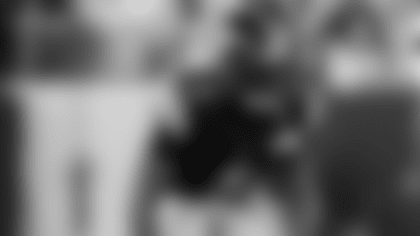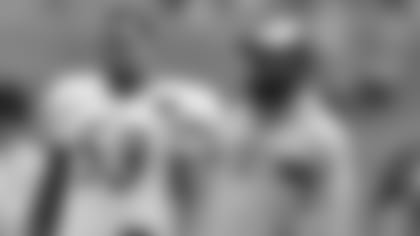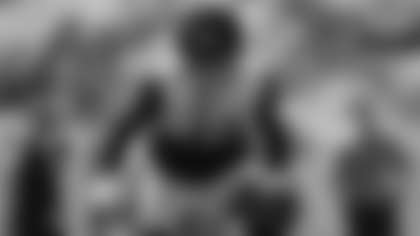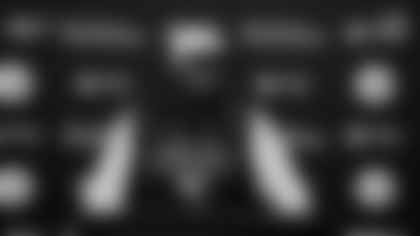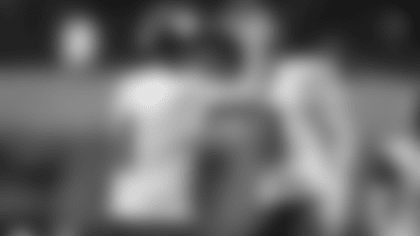Q. After last Sunday's game vs. the Chargers, and then again during your Tuesday news conference, you pointed to the performance on possession downs as one of the core reasons the game ended as it did. This is the regular season, and so you have maybe 4 work days to diagnose what's not working and also devise a path to a solution. Where do you start?
A. You start everywhere. When it's not unfolding the way that you like, you don't discount any component of the equation. It's schematics and strategy. We've got to do a better job of positioning guys to win in certain circumstances, the guys have got to make plays. We've got to divide the labor up more thoughtfully in an effort to highlight the strengths of individuals and the collective. That's just the general protocol for me. When we don't meet expectations, it's not specifically where to start. You don't assume anything. You look at all components of preparation, and you build. It doesn't necessarily mean that you do things dramatically different, but there's an emphasis, there's an intentional approach to the process in an effort to unearth what's amiss and to ensure better execution the next time. Sometimes and oftentimes, particularly at this level, it's never anything dramatic. It's subtle, but there's a difference between subtle and winning and losing.
Q. As that process continues, do you lean more toward adding things or eliminating things?
A. I think your natural inclination is to eliminate, because oftentimes it's not for lack of being in the right neighborhood, but it's just the fact that maybe you're knocking on the wrong doors, to use an analogy. And so generally, your natural inclination is to reduce, but certainly I'm not opposed to adding a wrinkle or two strategically in an effort to position guys for easier, more fluid success.
Q. Something else you mentioned in talking about the Chargers game was that their defense didn't employ a lot of pressure packages. You said, "Most people don't pressure Aaron (Rodgers) a lot." What does he have, or do, that discourages that?
A. His arm talent and his experience. The more people you use to rush at the passer, the fewer you have to distribute into coverage. Most people deploy 7-man coverage units, particularly in situational moments vs. experienced high-level quarterbacks. You start blitzing those guys, you thin out the coverage, you make their process in terms of reading where the ball should be distributed more fluid, and sometimes that doesn't help you when you're facing a guy with that experience and talent level.
Q. Beyond physical ability, what does a WR or a TE need to be able to get open in the NFL? Is it video study? Honing and then being able to use certain technique? Using an example of a guy who played for you — how did a player like Hines Ward get open?
A. Well specifically in regard to Hines, and it's a major component regarding anyone, is spatial awareness, because it's not always man-to-man. The ability to recognize zones and understand when you're in the innermost part of a zone, or the outermost part of the zone, how to be quarterback-friendly within zone concepts, to work back to the ball, to find the weak points in zones, etc. I think it's an innate feel thing. It's very similar to a basketball player who has the ability to work through zones. That spatial awareness component is definitely a component of success at that position.
Q. Bengals safety DJ Turner is 5-11, 195 pounds, and he was a No. 2 pick in the 2023 NFL Draft. He leads the NFL in passes defensed with 14, and you said that he largely traveled with DK [Metcalf] for one-on-one matchup purposes in the first meeting. Does that mean Turner was in single covering with DK Metcalf?
A. It does not. You know, I laugh sometimes when we talk about corners traveling in today's game. They use the term often, but there's not a lot of guys traveling the way that maybe Deion Sanders traveled or Darrell Green traveled. They're often still playing within the confines of schematics, with safety help over the top, for example. The interception that Turner had right before the half (in the first meeting), the ball was thrown to DK, but it was a 2-on-1 situation. Turner was low and underneath the safety, and Jordan Battle was over the top. And so he's certainly traveling to DK, and they do that for matchup purposes, but it's somewhat smoke-and-mirrors, because in most instances, he's still playing within a 2-on-1 concept. That happens a lot in today's game. The "lockdown corner," or the "Revis Island-like" corners, you don't see that as much as you used to years ago.
Q. So when you see that, or when an opponent chooses to do that, what do you need from the rest of the collective to blow that strategy up.
A. If someone's in a 2-on-1, that means others are in 1-on-1s. And so you challenge people to win their 1-on-1s, and it's as simple as that when it's man-to-man. But as I mentioned, a component of the matchup game, at least in the terms of this week, it's a little bit of smoke-and-mirrors. It's not always man-to-man. As a matter of fact, it's not man-to-man most of the time. It's usually within the confines of some relatable zones or some spot-drop zones. And so you get back to that spatial awareness component that we were talking about in terms of making yourself quarterback-friendly, ripping yourself open, and having the ability to create run after the catch.
Q. Earlier we talked about the difficulty in pressuring Aaron Rodgers a lot. Is Joe Flacco in that same category?
A. No question. If you study it analytically, and I know analytical information isn't widely available to the general public, but since he's been in Cincinnati, he's No. 1 in the NFL in terms of time-to-throw in most situations – first-and-10 play-pass, drop back possession downs, one-dimensional passing circumstances, etc. That's why he was such a big acquisition for them, to be quite honest with you, not only his experience, but the fluidity of his processing, his ability to make quick decisions and distribute the ball to appropriate people based on things that he's looking at.
Q. During the first 6 games of the season, Bengals RB Chase Brown was averaging 51 yards from scrimmage per game. In the last 3, he's averaging 106 yards from scrimmage per game. Is that him, an improvement in the offensive line, the way he's utilized, the Joe Flacco factor?
A. It's the Joe Flacco factor. I think with each passing week, Joe gets a sense of how people play him and them. They've got two dynamic players – Ja'Marr Chase Tee Higgins – and oftentimes it dictates how units play, particularly in one-dimensional passing moments. And I think last week was a really good example of that. Joe Flacco discovered Chase Brown last week. Brown caught 8 passes for 75 yards, and 70 of those yards were after catch. What happened was people were rolling up zone coverages on Chase and Higgins, or playing two-on-one and double-teaming Chase and Higgins, and so he looked to Brown as a potential winner. He liked the matchup of Brown vs. T.J. Edwards, outside the linebacker from Chicago, and they called upon it repeatedly. The biggest play probably in the game was a fourth-and-10 where he hit Brown against Edwards underneath in man-to-man, because there were double-teams on Higgins and Chase.
Q. Aaron Rodgers had his worst performance in a Steelers uniform last Sunday. What kind of a response did you see from him this week?
A. I saw a business as usual response. This is not his first rodeo. It's probably not his first bad game, even though I'm sure he won't admit it. You know, that's just life in this business. While at the same time, I'm sure he's chomping at the bit to bounce back and to respond to that. And so it's been a good week of prep. I'm excited to watch him play. You don't get to be Aaron Rodgers without the bounce-back factor. How you respond to negativity, how you smile in the face of adversity, and we get an opportunity to see him do that today.
Q. The first meeting vs. the Bengals this season was on Oct. 16, which is about a month ago, and in that game Ja'Marr Chase was targeted 23 times and finished with 16 catches. Did you learn anything from that game that might be used today by your defense in an effort to minimize his impact?
A. Without question. We certainly know his capabilities. It's about the lens through which Flacco sees the game and how Flacco administers the ball, based on his tools, his schematics, and what he sees from us. And the lens that each quarterback sees is a little bit different. And so there was more speculation from our perspective the first time we played him in terms of how Joe might operate within their system, how the ball might be distributed, etc. I think with each passing week, although he's getting more comfortable in terms of what he's being asked to do there, it also provides information for those he competes against. And so from our perspective, there's certainly less mystical equations this week and more definitive things. We're looking at a larger body of work. The last time we played, we were looking at one game that he operated on a short week. We really were his first full week of prep. And so there's less speculation as we prepare. There's less speculation as we divide our labor up. There's less speculation in terms of how Joe might distribute the ball in certain circumstances. And so we have a higher level of comfortability this week.
Q. Earlier in the week, Asante Samuel Jr., a fifth-year pro who had spinal fusion surgery in April, was signed to the practice squad. What do you remember about him when he was coming out for the 2021 NFL Draft?
A. I went to his Pro Day, and the way that he was highly regarded in Tallahassee, among his teammates and people in that program, really kind of touched me. I go to a lot of Pro Days, and I go to Tallahassee quite a bit. He was held in high regard, not only because of his talents, but because of his intangible things, his relationship with the game, the type of teammate he is, the type of worker he is, and sometimes those things leave an imprint on me more so than the tape. Everyone has access to the tape. We all do. But when you put your boots on the ground in their college towns, and you get an opportunity to talk to people and feel the impact of the human day in and day out on campus, in football settings and non-football settings, he certainly passed the test.
Q. And because spinal fusion surgery sounds serious, how did the process of adding him to the practice squad come about?
A. It was easy for us. Dr. David Okonkwo, our team doctor, did the surgery, and so we didn't have to go far to ask questions. When you have one of the best in the world, and we do in Dr. Okonkwo, a lot of people come to him, and it's a leg up for us sometimes when we're making decisions about people who certainly dealt with some of the things that he specializes in.



